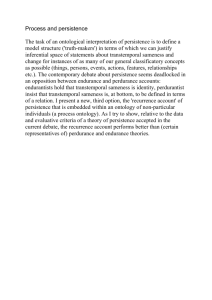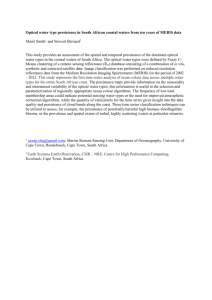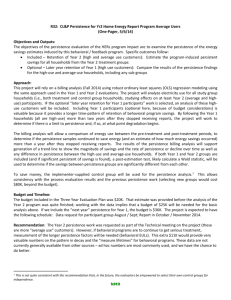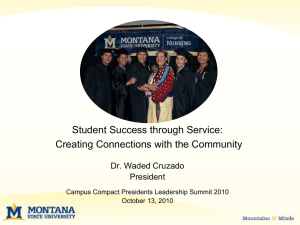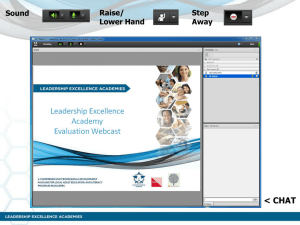Student Focus Group Data - Tulsa Community College
advertisement
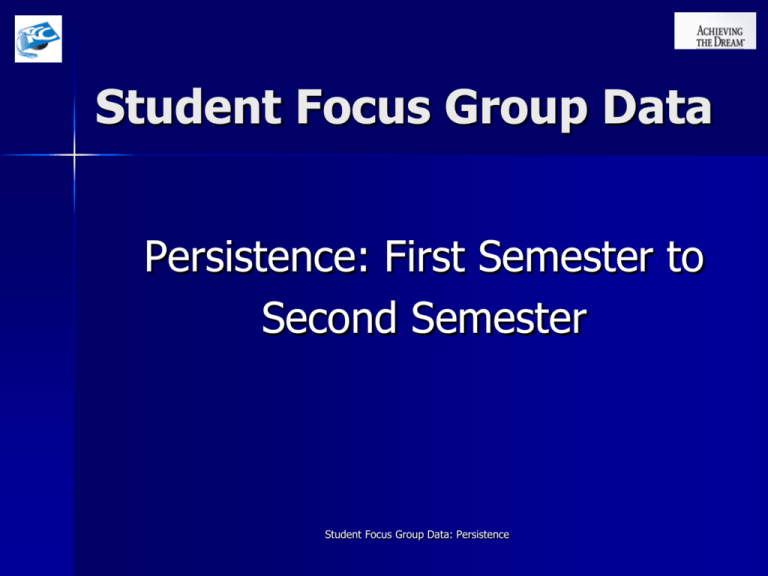
Student Focus Group Data Persistence: First Semester to Second Semester Student Focus Group Data: Persistence Four Components What’s Wrong? 25% of TCC’s first-time freshmen were not retained to the second semester. Why? Student Focus Group Data Interventions Data-driven Strategies Assessment Formative and Summative Student Focus Group Data: Persistence The Four Components What’s Wrong? Why? (Quantitative Data) (Student Focus Group Data) Goals Top Persistence • Persistence (Year 2 – 4 ) Barriers/Challenges • Developmental Reading (Year 3 – 4 ) • Developmental Math (Year 4 ) Revised Interventions New Interventions Policy Changes Questions • How do we revise current interventions to directly address common barriers? • What new interventions can be implemented to address common barriers? Qualitative Data • What policy changes need to be made to address common barriers? Student Focus Group Data: Persistence Assess Impact Assessments Formative: • To what extent did interventions (or policy changes) effectively address common barriers? Summative: • To what extent did interventions increase persistence? Student Focus Groups Demographics: Gender Focus Group AtD Cohort 72% 59% 41% 28% Males Females Student Focus Group Data: Persistence Student Focus Groups Demographics: Ethnicity Focus Group AtD Cohort 71% 60% 16% 14% 10% 2% 4% 1% 2% African American Asian 11% Caucasian Hispanic Student Focus Group Data: Persistence Native American 5% 2% Other Student Focus Groups Demographics: Age Focus Group AtD Cohort 72% 72% 8% 12% 2% Under 21 21-24 7% 9% 25-29 Student Focus Group Data: Persistence 6% 30-39 9% 3% 40 and Older Other Subgroups 4% African American males in both AtD Cohort and focus groups 44% Tulsa Achieves students Mean average age was • 22.7 years for Focus Groups (more 18 year olds with Tulsa Achieves) • 24.5 years for AtD Cohort Mean average age of non-Tulsa Achieves students was 25.8 years. Student Focus Group Data: Persistence Definition of Terms Student Focus Group Barrier/Challenge Frequency Cluster Student Focus Group Data: Persistence Student Focus Groups Three focus groups per campus 12 total groups 101 total students Students volunteered and were accepted if they had completed their first semester in Fall 2007 and had reenrolled in Spring 2008. Student Focus Group Data: Persistence Barrier/Challenge Barrier/Challenge “All students experience barriers or challenges as they make their way toward graduation.” Common barriers include those experienced at TCC and those connected to life circumstances. Student Focus Group Data: Persistence Frequency Barriers/Challenges - Frequency • By Raw Total • By Group • By Campus Student Focus Group Data: Persistence Cluster Barriers seemed related to each other. Data Team classified barriers into larger clusters or categories to provide the best overall picture of the data. Student Focus Group Data: Persistence General Findings No single barrier was mentioned in every focus group on all four campuses. Many barriers occurred frequently and were identified on all four campuses. Barriers specific to individual campuses did not occur frequently overall; College-wide barriers were identified far more frequently overall. Student Focus Group Data: Persistence Most Frequent Barriers/Challenges Adjusting to college (19) Balancing school and life (15) Textbook issues (13) Tulsa Achieves implementation issues (13) Communication issues with instructors (12) Choosing courses (8) All six barriers/challenges were identified on all four campuses. Student Focus Group Data: Persistence Specific Findings 82% of all barriers/challenges fell into one of three clusters: Academic Barriers (63) Service Barriers (53) Adjustment Barriers (48) Student Focus Group Data: Persistence Academic Barriers (63) 63 Academic Barriers were grouped into two types: • Instructional Issues (33) • Student Issues (30) Student Focus Group Data: Persistence Academic Barriers Instructional Issues (33) • Communication issues with instructors (12) • Instructional quality (6) • Understanding instructor’s course requirements (6) • Instructor attitudes (2) Student Focus Group Data: Persistence Academic Barriers Student Issues (30) • • • • • • • Choosing courses (8) Meeting academic workload (8) Using Blackboard and MyTCC email (4) Academically underprepared (3) Lacking computer proficiency (3) Course placement (3) Choosing a major (1) Student Focus Group Data: Persistence Service Barriers (53) Textbook issues (13) Poor customer service (8) Financial Aid service (8) Confusing enrollment process (7) Limited times and locations of classes (6) Finding your way around campus (5) Parking (5) Inter-campus communication (1) Student Focus Group Data: Persistence Adjustment Barriers (48) Adjusting to college (19) Balancing school and life (15) Time management (7) Lack of motivation (7) Student Focus Group Data: Persistence Tulsa Achieves Implementation Issues 13 barriers/challenges identified These were not included in the three clusters. Examples: • Paying for textbooks • Financial aid processing • Information about TA changed and sometimes not accurate Student Focus Group Data: Persistence The Four Components What’s Wrong? Why? (Quantitative Data) (Focus Group Student Data) Goals Top Persistence Barriers: • Persistence (Year 2 – 4 ) 1. Adjusting to college 2. Balancing school and life • Developmental Reading (Year 3 – 4 ) • Developmental Math (Year 4 ) 3. Textbook issues 4. Tulsa Achieves implementation issues 5. Communication issues with instructors 6. Choosing courses Revised Interventions New Interventions Policy Changes Questions • How do we revise current interventions to directly address common barriers? • What new interventions can be implemented to address common barriers? • What policy changes need to be made to address common barriers? Student Focus Group Data: Persistence Assess Impact Assessments Formative: • To what extent did interventions (or policy changes) effectively address common barriers? Summative: • To what extent did interventions increase persistence? Next Steps * * * TCC’s goal is to achieve a 3% increase in student persistence each year. Based on the data, major barriers are selected for intervention and improvement. Intervention and assessment strategies are then devised or modified for the selected barriers. Student Focus Group Data: Persistence


